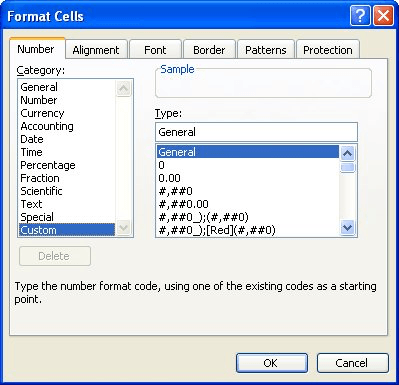Written by Allen Wyatt (last updated June 27, 2020)
This tip applies to Excel 97, 2000, 2002, and 2003
Some people use Excel to help keep track of elapsed time. This may sound like a rather esoteric use of Excel, but it is not, really. For instance, you may develop a timesheet. You enter a starting time in a cell, an ending time in another cell, and then calculate the elapsed time between the two by simply subtracting the starting time from the ending time.
If you use Excel in this way, you may have a need to display your results in just minutes, with no hours showing. You can do this in one of two ways. The first is to simply format the cell containing the aggregate of your elapsed times. Follow these steps:

Figure 1. The Number tab of the Format Cells dialog box.
Your cell now contains only elapsed minutes. This is great for displaying results, but you may actually want a cell to literally contain a number representing the number of elapsed minutes. This need brings us to the second solution: simply multiply the aggregation cell by 1440 and format the result as a regular number (not as a date or time). This effectively takes a value out of the special date/time format maintained by Excel and puts it back into the realm of regular numbers.
ExcelTips is your source for cost-effective Microsoft Excel training. This tip (2820) applies to Microsoft Excel 97, 2000, 2002, and 2003.

Program Successfully in Excel! This guide will provide you with all the information you need to automate any task in Excel and save time and effort. Learn how to extend Excel's functionality with VBA to create solutions not possible with the standard features. Includes latest information for Excel 2024 and Microsoft 365. Check out Mastering Excel VBA Programming today!
Excel allows you to store times in a worksheet. If you want to use Excel to time certain events, there are a couple of ...
Discover MoreNeed to know how many days there are between two dates? It's easy to figure out—unless you need the figure in ...
Discover MoreDon't want to use the EOMONTH function to figure out the end of a given month? Here are some other ideas for discovering ...
Discover MoreFREE SERVICE: Get tips like this every week in ExcelTips, a free productivity newsletter. Enter your address and click "Subscribe."
There are currently no comments for this tip. (Be the first to leave your comment—just use the simple form above!)
Got a version of Excel that uses the menu interface (Excel 97, Excel 2000, Excel 2002, or Excel 2003)? This site is for you! If you use a later version of Excel, visit our ExcelTips site focusing on the ribbon interface.
FREE SERVICE: Get tips like this every week in ExcelTips, a free productivity newsletter. Enter your address and click "Subscribe."
Copyright © 2025 Sharon Parq Associates, Inc.
Comments